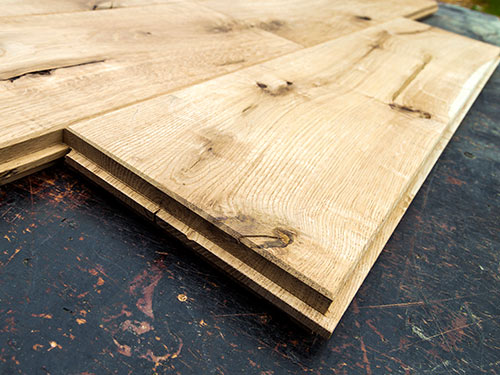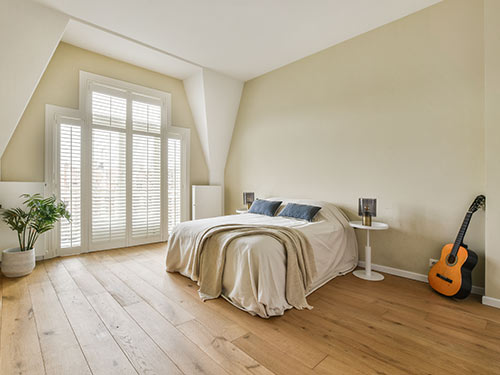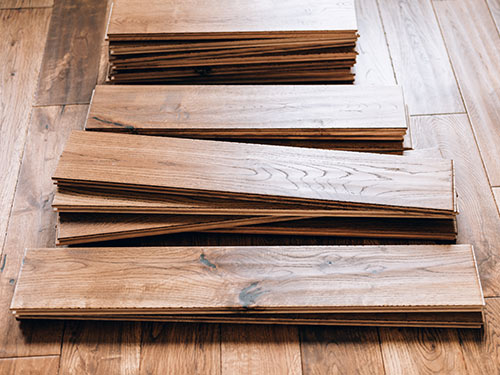Back to Flooring Products
Wood Floorboards: Types, Benefits, Costs & Care Guide
 Wood floorboards are individual timber planks used to create a warm, natural and long-lasting floor. Whether you prefer the charm of traditional boards or the precision of modern manufacturing, wood floorboards offer an unbeatable mix of character, durability and value.
Wood floorboards are individual timber planks used to create a warm, natural and long-lasting floor. Whether you prefer the charm of traditional boards or the precision of modern manufacturing, wood floorboards offer an unbeatable mix of character, durability and value.
In this guide, you’ll learn about the different types of wood floorboards, their pros and cons, installation methods, cost factors, maintenance tips, trends, and how to solve common issues. If you’re browsing options right now, start with our range of engineered wood floorboards and classic parquet floorboards.
What Are Wood Floorboards?
Wood floorboards are long, flat pieces of timber designed to interlock or fit side by side to create a seamless wooden floor. They have been used for centuries in homes and buildings, valued for their natural appearance, durability, and the ability to be repaired or refinished over time.
Today, floorboards are available in different constructions to suit various needs. Solid wood floorboards are made from a single piece of timber, offering authenticity and long life. In contrast, engineered floorboards are made from multiple layers, giving them excellent stability and making them suitable even for underfloor heating systems. Another popular choice is reclaimed floorboards, which bring unique character and sustainability benefits.
Compared to laminate or vinyl, wood floorboards provide a more natural flooring solution that can last for generations with the right care.
Types of Wood Floorboards
There are several different types of wood floorboards, each with unique benefits depending on your style preferences, budget, and installation requirements. Below are the most common options homeowners consider:
Solid Wood Floorboards
Crafted from a single piece of hardwood such as oak or walnut, these boards are the most traditional choice. Solid wood floorboards can be sanded and refinished many times, making them a lifetime investment. They are ideal for those seeking a natural and authentic wooden floor.
Engineered Wood Floorboards
Engineered wood floorboards consist of multiple layers with a hardwood veneer on top. This construction provides stability and resistance to moisture, making them suitable for areas like kitchens and homes with underfloor heating.
Reclaimed Wood Floorboards
For those who appreciate sustainability and character, reclaimed floorboards are salvaged from old buildings and repurposed. They bring a rustic charm and a unique story to your interior while reducing environmental impact.
Softwood vs Hardwood Floorboards
Softwood boards (like pine) are more affordable and can add a bright, casual look, while hardwood boards (such as oak, ash, or walnut) offer higher durability and a more luxurious appearance. The choice depends on the balance between budget and long-term performance.
Comparison of Different Floorboard Types
| Type |
Durability |
Refinishing Potential |
Cost |
Best For |
| Solid Wood |
High |
Multiple times |
£££ |
Traditional homes, long-term investment |
| Engineered Wood |
Very High |
1–3 times |
££ |
Modern homes, underfloor heating |
| Reclaimed Wood |
Medium to High |
Varies |
££–£££ |
Eco-conscious projects, rustic style |
| Softwood |
Medium |
1–2 times |
£ |
Budget-friendly, casual spaces |
| Hardwood |
High |
Multiple times |
£££ |
Luxury look, high-traffic areas |
Benefits of Choosing Wood Floorboards
Wood floorboards deliver a rare mix of natural beauty and long-term value. From performance to aesthetics, here are the key reasons homeowners choose timber boards over alternatives.
- Timeless, natural look: Real wood grain, warmth and character that never go out of style.
- Long lifespan: Quality boards can last for decades with proper care, and many can be re-sanded and refinished to look like new.
- Adds property value: Wooden floors are a desirable feature that can improve buyer appeal.
- Custom finishes: Choose from oiled, lacquered or hardwax finishes, plus stains from light whitewash to deep espresso.
- Design flexibility: Go wide plank for a modern, spacious feel or opt for classic patterns like parquet.
- Comfort underfoot: Wood feels warmer and softer than tile or stone, and helps reduce echo.
- Repairable: Individual boards can be repaired, replaced, or refinished—far more sustainable than ripping out a whole floor.
- Better indoor climate: Wood helps regulate humidity by absorbing and releasing moisture naturally.
- Compatible options: Modern engineered floorboards offer improved stability and are suitable for underfloor heating.
If you want the look of solid timber with added stability, explore our range of engineered wood floorboards.
Common Uses of Wood Floorboards in the Home
 Wood floorboards are versatile and can enhance almost every room in a property. Their adaptability makes them one of the most popular flooring choices for both traditional and modern interiors.
Wood floorboards are versatile and can enhance almost every room in a property. Their adaptability makes them one of the most popular flooring choices for both traditional and modern interiors.
- Living Rooms: Create a welcoming and elegant atmosphere with the natural warmth of timber. Wide planks are especially popular for making living areas feel spacious and luxurious.
- Bedrooms: Wood adds a cosy and calming touch, making bedrooms feel more comfortable. Lighter shades of oak or ash are often chosen to promote a relaxing environment.
- Kitchens: With the right finish, such as lacquered or oiled boards, wood can stand up to daily use and occasional spills. Engineered wood is recommended here for its extra stability.
- Hallways & Entrances: These high-traffic areas benefit from the durability of hardwoods like oak. They not only handle well but also make a strong first impression.
- Commercial Spaces: From offices to boutique shops, wooden floorboards convey professionalism and premium quality while offering long-term performance.
Installation Methods for Wood Floorboards
The way your wood floorboards are installed can greatly affect their performance, durability and appearance. Choosing the right method depends on your subfloor, budget, and whether you prefer DIY or professional fitting.
Nail-Down Installation
This traditional method involves securing floorboards directly to a wooden subfloor using nails. It creates a strong, permanent bond and is commonly used for solid wood floorboards. Best suited for experienced fitters or professionals.
Glue-Down Installation
Boards are fixed to the subfloor with adhesive, ensuring excellent stability and reduced movement. This method also improves sound insulation, making it popular for apartments and commercial spaces. Many engineered floorboards are well-suited for glue-down installation.
Floating Installation
Here, boards are not fixed to the subfloor but instead click or lock together, "floating" above an underlay. This method is quick, cost-effective and often used with modern click-system floorboards. It’s ideal for DIY projects and minimises mess during fitting.
Subfloor Preparation
No matter the method, proper preparation is essential. Subfloors must be clean, level and dry. Adding an underlay can provide moisture protection, sound insulation and extra comfort underfoot.
Cost of Wood Floorboards
The price of wood floorboards varies widely depending on the material, construction, and finish you choose. While real wood is a long-term investment, it’s essential to understand the factors that influence the total cost.
Average Prices
- Solid wood floorboards: Typically range from mid to high price levels, with premium species like walnut or exotic woods costing more.
- Engineered wood floorboards: More budget-friendly than solid wood, offering excellent value without compromising on style and durability.
- Reclaimed floorboards: Costs can vary greatly depending on availability and condition, but they often appeal to homeowners seeking a unique, eco-friendly option.
Factors That Affect Price
- Wood species: Oak and ash are popular mid-range choices, while walnut or exotic species command higher prices.
- Thickness and width: Thicker boards with wider planks tend to cost more but provide greater stability and impact.
- Finish: Pre-finished boards with oil, lacquer, or hardwax will be slightly more expensive but save time on installation.
- Grading: Prime grades with fewer knots are more expensive than rustic grades with visible character marks.
Installation Costs
The total budget should also include the cost of installation. While DIY can reduce costs, professional fitting ensures the boards are laid correctly and will perform well for years to come. Explore our floor fitting services if you’d like expert installation in London and across the UK.
Maintenance & Care for Wood Floorboards
With the right care, wood floorboards can last for generations. Regular maintenance not only keeps them looking beautiful but also protects your investment from everyday wear and tear.
Regular Cleaning
- Sweep or vacuum: Remove dust and grit daily to prevent scratches.
- Damp mop: Use a well-wrung mop with a wood-friendly cleaner—avoid excess water as it can damage boards.
- Protect from furniture: Add felt pads under chairs and tables to prevent dents and marks.
Protective Finishes
Applying the right finish can extend the life of your floorboards. Options include lacquer for a durable, glossy look, oil for a natural finish that enhances the grain, and hardwax oil for a balance of protection and style. Each requires reapplication over time, depending on foot traffic.
Refinishing Floorboards
One of the biggest advantages of real wood is that it can be sanded and refinished. Over time, scratches, stains, and dullness can be removed, giving your floor a fresh start. Our professional sanding service can restore even heavily worn floors.
Repairs & Minor Issues
- Gaps: These can appear with seasonal changes and may be filled if they become excessive.
- Scratches: Light marks can often be polished out, while deeper ones may require sanding.
- Squeaks: Loose boards or nails can cause squeaking, which can be fixed with professional repair methods.
Common Problems with Wood Floorboards & Solutions
 Even the highest-quality wood floorboards can face challenges over time. The good news is that most issues have reliable solutions that can restore both the appearance and performance of your floor.
Even the highest-quality wood floorboards can face challenges over time. The good news is that most issues have reliable solutions that can restore both the appearance and performance of your floor.
- Gaps Between Boards: Seasonal changes in humidity cause wood to expand and contract. Small gaps are normal, but larger ones can be filled using professional gap filling methods.
- Scratches & Dents: Everyday wear, pets, or furniture movement can leave marks. Light scratches may be polished out, while deeper damage often requires scratch repair or sanding.
- Squeaking or Creaking Boards: Caused by loose nails, movement, or subfloor issues. These can be addressed with specialist repair techniques to secure the boards.
- Water Damage: Spills or leaks can stain or warp boards. Quick action is key—minor damage may be sanded out, but severe cases might require board replacement.
- Cupping or Warping: When boards curl upwards at the edges, it usually indicates a moisture imbalance. Proper ventilation, dehumidifiers, and professional sanding can help restore the floor’s flatness.
- Loose Boards: Over time, boards may shift or lift. They can often be resecured without replacing the entire floor.
By addressing problems early, you can avoid costly repairs and keep your floorboards in excellent condition for many years.
FAQs About Wood Floorboards
Homeowners often have questions when choosing or maintaining wood floorboards. Here are some of the most common queries, answered by our experts:
Are wood floorboards suitable for underfloor heating?
Engineered wood floorboards are an excellent choice for underfloor heating due to their layered construction, which resists warping. Solid wood is generally not recommended as it expands and contracts more with temperature changes.
Can I install wood floorboards in a bathroom?
While wood can be used in bathrooms with proper sealing, it’s not the most practical choice due to constant moisture. Alternatives like LVT/SPC flooring offer a wood-look finish with superior water resistance.
How often should floorboards be refinished?
This depends on the type of wood and finish, but on average, every 7–10 years. High-traffic areas may need attention sooner, while low-use rooms can go much longer between sanding and refinishing.
Do wood floorboards increase property value?
Yes. Real wood floors are considered a premium feature in homes, often making properties more attractive to buyers and increasing resale value compared to carpet or vinyl.
What’s the difference between solid and engineered wood floorboards?
Solid boards are cut from a single piece of timber, offering authenticity and multiple refinishing options. Engineered boards have a hardwood surface layer over a stable core, making them more resistant to moisture and compatible with modern installation methods.
Conclusion
Wood floorboards remain one of the most reliable and beautiful flooring choices for homeowners who want durability, style, and long-term value. With options ranging from traditional solid timber to versatile engineered boards and even eco-friendly reclaimed wood, there’s a solution for every home and lifestyle.
By choosing the right type of floorboard, installing it correctly, and following proper maintenance, you can enjoy a floor that will last for decades while adding warmth and character to your property.
Ready to upgrade your home with timeless wooden flooring? Explore our full range of engineered wood floorboards, discover elegant parquet styles, or choose from our collection of laminate alternatives for a more budget-friendly option. If you need expert fitting, our floor installation services are available across London and the UK.
Contact our team today to discuss your project, request a free consultation, or book a professional fitting service. Let’s help you create a floor you’ll love for years to come.